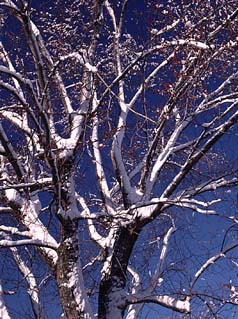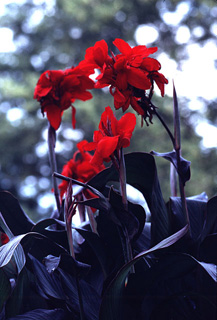Digital has virtually replaced all film shooting. That is, except for some of us. Yes, I have embraced digital. But for large prints, my medium format negatives and transparencies give me stunning enlargements. Plus, I like to shoot film and I've spent quite a while trying to find the best labs to do work for me. I talk here generally about the films I use and specifically about labs in the Boston area.
 This is the first
question I am most asked by new shooters.
I began with slide film. I learned
that slide film has many things going for it: there is no room for error
in the printing process because there is no printing process, processing
is relatively cheap, contrast can be phenomenal, my experience is that
it tends to scan more easily than negatives, it certainly stores more
easily than negatives, it can be projected to life size, and it can be
printed with great results. So, my general rule-of-thumb is that I
generally shoot slide film, but when I am going to need lots of prints
to give away or shooting black and white or need higher ISOs, I go for
the negative film.
This is the first
question I am most asked by new shooters.
I began with slide film. I learned
that slide film has many things going for it: there is no room for error
in the printing process because there is no printing process, processing
is relatively cheap, contrast can be phenomenal, my experience is that
it tends to scan more easily than negatives, it certainly stores more
easily than negatives, it can be projected to life size, and it can be
printed with great results. So, my general rule-of-thumb is that I
generally shoot slide film, but when I am going to need lots of prints
to give away or shooting black and white or need higher ISOs, I go for
the negative film.
You will need a projector screen, light box, and a loupe. This setup can be a bit costly (though all of them you can get used on Ebay). You can also make a light box yourself, using 5000K bulbs (you can get these at Home Depot), making a housing, and putting on top a nice piece of frosted glass or plexiglass. If you really want to be cheap, you can use your 50mm lens as a 4x magnifier and your 28mm as an 8x magnifier, so you don't have to buy a loupe. Loupes are somewhat subjective. I started out by using the lenses as my loupes and then after I became more proficient, I started looking at buying real loupes. You plop the 50mm down on the light table front of the lens on the table, set it at 1.4, and look through. You should see a nice picture. For the 8x, you reverse the 28mm lens so you can see details and see if your shot is sharp. This setup worked quite well for me, until I got fed up with the inconvenience and bought a great 4x Rodenstock.
 No. Don't think you cannot make
prints from slides. You can, and they can come out fantastic. All
prints involve scanning and printing on good papers. For that
eye-popping Cibachrome look you can use metallic and supergloss papers.
But I've been having all my prints made on professional matte paper and
have been really happy.
No. Don't think you cannot make
prints from slides. You can, and they can come out fantastic. All
prints involve scanning and printing on good papers. For that
eye-popping Cibachrome look you can use metallic and supergloss papers.
But I've been having all my prints made on professional matte paper and
have been really happy.
In the Boston area, as of March 2007, I take the public transport (the "T") to ColorTek on Atlantic Avenue in Boston (across from the South Station bus terminal) and use them for general work (small prints, small scans, etc). They do a good job. They do all my E6 and C41 and I get a PhotoCD from them. They are reasonable. They don't do a good job on large prints. For large prints (greater than 11x14), I've been driving to Dorian Color Lab in Arlington for their Imacon scans (a virtual drum scan) and prints. They use a Durst Epsilon digital photographic printer and print to Kodak Endura papers. I use Dorian exclusively now for large prints. When I lived in West Roxbury, I used Color Services in Needham. They do canvas prints digitally and still do analog C-prints from film.
If you don't live in Boston, check photo.net for lab recommendations or just use A&I mail order; they do excellent work. For cheapest E6, you can use Fuji mailers. I've stopped using them because I don't like using the cardboard mounts/dust and I don't mind the extra expense (plus they aren't really that cheap anymore). For professional portrait photography solutions, visit Lustre Color in Canton, MA.
Yes. But, Astia and Sensia both have very wide exposure lattitude. If you do shoot slides, you will need to test your in-camera meter. To do this, set it at the ISO/ASA for your film (let's say it's 100). This test worked for me: Pick two scenes, a person posing in diffuse light outdoors and a scenic well-light skyline-type picture. Set the shutter speed so that it gives you an f/8 aperature. Then take 9 shots for each scene by changing only the ISO setting on your camera: 25, 50, 64, 80, 100, 120, 160, 200, and 400. For the person shots, use a 50mm lens and a 135mm lens. For the scenic, use 28mm and 50mm lenses. This will give you 36 shots total. Then you evaluate the results by setting the slides on your light table. Verify the extremes first. The ISO 25 shots should be well overexposed, the ISO 400 shots should be well underexposed. You can determine which ISO gives the best exposure (e.g., it may be 100 which is what you expect, but it maybe more or less depending on the calibration of your meter). Just remember: for slide film, expose for the highlights and for negative film expose for the shadows.
For slides with people, I shoot Astia 100 ISO. For non-people pictures, I am using Fuji Velvia 50 and Provia 100F. I use a light box and various loupes to evaluate my slides and I archive the good ones in archival sheets and binders. For negative film, I shoot Fuji Pro 160S and Kodak Portra 160NC and 400NC for color portraits and Kodak TMX-100 and Ilford XP-2 Super (C-41) for black and white.
I hope this little summary of my experiences helps you.